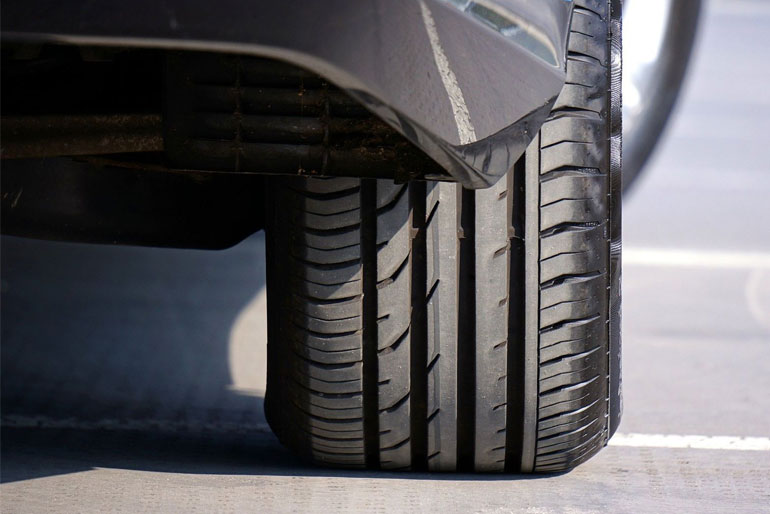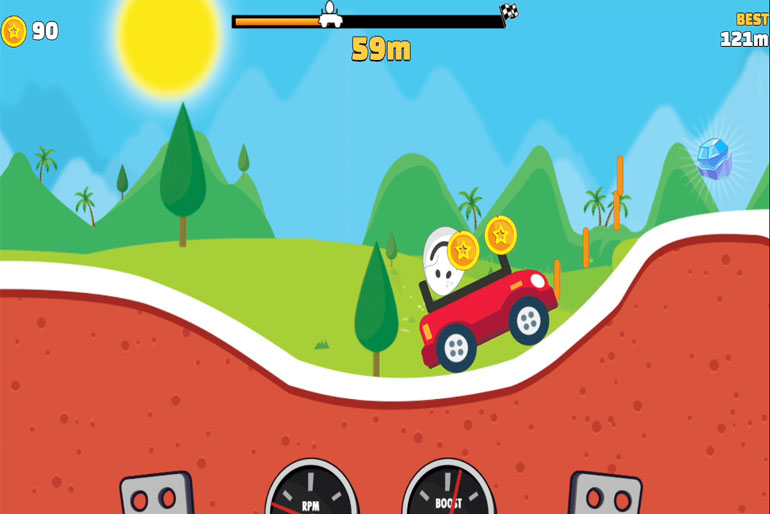If you’ve ever balanced a spoon on your finger just to see how long it stays there, you already understand the heart of Eggy Car. It’s a small, free game about driving a car with a fragile egg perched on top. Your job sounds easy: roll forward, climb hills, go as far as you can without letting the egg tumble and crack. But like many good ideas, the magic is in the details. The slopes are sneaky, the bumps are bigger than they look, and your own nerves become part of the challenge. One minute you’re cruising along; the next, a tiny dip sends your egg flying.
This article breaks down why Eggy Car works so well, how to play better, and what the game quietly teaches you about patience, rhythm, and control. No jargon, no complicated breakdowns—just a friendly guide to a charming little time sink.
What Eggy Car Is All About
Eggy Car is a physics-based driving game. You control a small car with an egg in a little basket or holder on top. The road is a rolling series of hills and dips. You press one button to go forward and another to slow down or go backward. The egg also has weight and wants to keep moving when you start or stop. If you rush uphill, the egg tilts backward. If you race downhill and hit a bump, it may leap into the air. Your goal is to keep moving while keeping the egg steady.
There’s no complex story. There’s no huge list of items to collect. It’s you, the car, the egg, and the road. That simple setup is part of the appeal. You can start a run in seconds, try your best, and instantly want to try again.
Why It’s Addictive (in a Good Way)
1) Tiny sessions, big tension
Runs are short. You can play during a break, while waiting for water to boil, or between tasks. But even in a minute-long run, the game creates suspense. Every hill feels like a small puzzle: how fast should you go? Should you slow before the peak? That tension keeps your brain focused.
2) One clear rule
Don’t let the egg break. That’s it. When your goal is that clear, there’s no confusion about what to do next. You always know why you failed, too, which makes it easy to jump right back in and do better.
3) A fair kind of difficulty
The game is hard, but not unfair. It punishes recklessness and rewards smooth driving. Think of it as a gentle coach: it doesn’t yell, but it always shows you how your choices affect the egg.
The Controls and How They Feel
You usually get two buttons: forward and backward. The forward makes the car roll ahead. Backward slows the car or drags it back a little. That’s the whole control scheme, yet it leads to surprisingly deep play.
- Forward: Tap lightly to nudge the car, or hold to build speed.
- Backward: Tap to keep the egg from tipping too far forward. Hold if you need to ease down a steep slope.
Because the egg slides with the car’s movement, big, sudden bursts can send it bouncing. The best runs often look calm from start to finish.
The “Secret” Physics (Explained Simply)
You don’t need to be into science to enjoy Eggy Car, but it helps to remember two simple ideas:
- Things like to keep moving the way they’re already moving.
When your car stops, the egg wants to keep going. That’s why hard braking can fling it forward. - Hills change how weight shifts.
Climbing pushes the egg back; rolling down pushes it forward. If you power up a steep hill too fast, the egg may tilt backward and pop out. If you rush down, it may slide forward and bounce.
Use that knowledge like a gentle guide. It’s not about perfect numbers. It’s about feeling how the egg reacts and adjusting before it’s too late.
Simple Strategies That Work
1) Feather your speed
Instead of holding forward all the time, try tapping in short bursts. This keeps the car moving but reduces sudden jolts.
2) Ease before the peak
As you approach the top of a hill, gently let off the gas. A small pause at the crest gives the egg time to settle so you don’t launch it on the way down.
3) Brake on the way down
Tap the backward button as you descend. This stops the egg from rocketing forward. Think of it as catching the egg with gentle hands.
4) Use the land
If you see a bump ahead, slow slightly before you hit it. That way, your car rolls over instead of bouncing. If there’s a long flat stretch, that’s your chance to pick up a little safe speed.
5) Keep your rhythm
Good runs feel like music. Tap-tap forward up a slope, pause at the top, tap-tap backward down the other side. Your rhythm becomes a tool.
Common Mistakes (and How to Fix Them)
Mistake 1: Flooring it from the start
It’s tempting to mash forward right away. That first burst throws the egg backward and can make it wobble for the next few hills. Fix: Start with two or three light taps to get rolling smoothly.
Mistake 2: Panicking on steep hills
You see a wall of a slope and hold forward. The egg tilts back, the car flips, and it’s over. Fix: Approach steep sections with patience. Tap forward, pause, tap again. If the egg leans too far back, ease off to let it settle.
Mistake 3: Ignoring the downhill
Going down feels safe, so players often speed up. That’s when the egg slides forward and pops out. Fix: Tap the backward button on the way down. Think of it as a soft hug for the egg.
Mistake 4: Overcorrecting
You see the egg wobble and slam the opposite button. That hard switch can be worse than the original wobble. Fix: Make small corrections. Quick, light taps are better than big swings.
A Step-by-Step Plan to Improve
- Play three very slow runs.
Your goal is not distance. Your goal is calm movement. Try to glide over three or four hills without a single big bounce. - Focus on the peaks.
For your next few runs, practice easing off right before each hilltop. Learn how it feels when the egg stays snug. - Practice descents.
Pick a run where you only care about going down safely. Each time you crest a hill, let the car roll and tap backward to keep the egg from surging forward. - Combine the two.
Now do a full run thinking, “slow at the top, gentle braking down.” Notice how much farther you get. - Set tiny goals.
Try to pass one more hill than your previous best. Small wins add up fast.
On Fuel, Coins, and Unlocks (If Your Version Has Them)
Some versions add fuel cans on the road. Grab them when you can, but don’t risk the egg for a tricky can. A careful line is better than a wild dive for fuel. If there are coins or parts to buy new cars or baskets, consider upgrades that help stability over speed. A heavier or wider platform can make the egg wobble less, though it may feel slower. Pick what fits your style: calm and steady beats fast and bouncy almost every time.
Mindset Matters More Than You Think
Eggy Car is a small lesson in self-control. The game rewards patience, not aggression. If you arrive with a restless mood, you might push too hard and crash early. Try a different approach:
- Breathe before you start a run.
One slow breath can lead to a smoother first hill. - Treat each hill as a mini-challenge.
Don’t think about a giant score. Think about the next peak and the next descent. - Let go after a crash.
Crashes happen. Smile, restart, and use what you learned.
Playing With Kids (or Anyone New to Games)
Eggy Car is great for kids because the rules are simple and the stakes are low. If you’re introducing someone to it:
- Show them the two buttons and nothing else.
- Encourage slow taps rather than holding.
- Celebrate short runs.
- Take turns: one person drives up the hill, the other handles the descent. Switching roles can be both fun and instructive.
It can also be a nice way to relax with someone who doesn’t usually play games. The learning curve is friendly, and the laughs are easy.
A Few “Advanced” Tricks Without Fancy Terms
- The micro-pause at the crest:
Lift your finger for half a second right at the top. This reduces launch risk on the downhill. - Counter-lean on bumps:
If the egg starts tipping forward after a rough patch, a quick backward tap can bring it back. If it leans back, a short forward tap helps it settle. - Soft landings:
When your wheels leave the ground even a little, avoid pressing forward until you land. Let the car touch down first, then nudge. - Reading the road:
You’ll start to notice patterns: a large hill often hides a small dip after it; a gentle slope may mask a sharp bump. Train your eyes to look two hills ahead so you can plan.
Comparing It to Other Casual Games
There are many one-button or two-button games with simple rules. What sets Eggy Car apart is how your hands, eyes, and sense of balance all work together. It’s not about perfect timing on a meter or reacting to bright flashes. It’s about learning a rhythm that feels almost physical. When you get it right, the whole run feels smooth, like gliding on a calm wave.
Making Your Own Little Challenges
If you want to spice things up without changing the game:
- The “No Rush” challenge:
See how far you can go while never holding forward for more than one second at a time. - The “Perfect Peak” run:
Try to crest ten hills in a row without a single bounce. - The “Downhill Doctor” goal:
Focus only on the descents for one run, tapping backward in a clean rhythm every time. - The “Ten-Minute Practice” plan:
Set a timer for ten minutes and play patiently. End the session no matter what your score is. Consistent short practice can be more helpful than one long, frantic attempt.
When Frustration Shows Up
Every player hits a wall. You get stuck at the same distance or fail on the same nasty slope. Here are a few quick resets:
- Change your grip.
Hold your phone differently for a run or two. A small change can relax your hands and improve control. - Turn off sound for a bit.
Some people focus better with less noise. Others do better with the sound on. Try both. - Take a short break.
Two minutes away can reset your patience and your touch. - Watch your last mistake.
Think about the exact moment things went wrong. Was it a heavy push on the gas? Did you forget to slow down at the top? Fixing one tiny habit often leads to a big improvement.
What Eggy Car Quietly Teaches
- Patience: Rushing rarely helps.
- Precision: Small taps beat big swings.
- Awareness: Looking ahead matters more than reacting late.
- Acceptance: You’ll crack the egg many times—and that’s okay.
These lessons carry over to other areas: biking down a hill, carrying a cup filled to the brim, or even working on a tricky task. Steady and calm win more often than you’d think.
A Handy Checklist Before Each Run
- Relax your hands.
- Start with gentle taps.
- Approach peaks slowly.
- Tap backward on descents.
- Look two hills ahead.
- Smile after a crash. Try again.
Put this in your head, and you’ll notice longer and calmer runs.
Final Thoughts
Eggy Car is proof that small ideas can be the most fun. It’s a snack-sized game with a soft challenge and a warm sense of humor. You don’t need special skills or deep knowledge. You only need a bit of patience and a willingness to learn from tiny mistakes. The more you play, the more you’ll find your own rhythm—tap forward, ease at the peak, tap backward, breathe, repeat.
So the next time you have a spare minute and want something light but satisfying, fire up Eggy Car. Treat each hill like a small dance step, keep your egg safe, and enjoy the ride. With steady hands and a calm mind, you’ll go farther than you think. And when the egg finally falls—because it will—laugh, reset, and roll again. That’s the simple joy at the heart of this little game.







